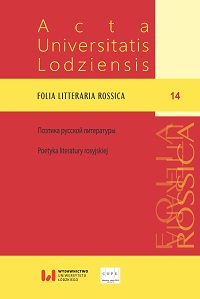Феномен молчания в современной русской прозе (романы Евгения Водолазкина, Людмилы Улицкой и Гузель Яхиной)
The Phenomenon of Silence in Contemporary Russian Fiction (The Novels of Yevgeny Vodolazkin, Lyudmila Ulitskaya and Guzel Yakhina)
Author(s): Tünde SzabóSubject(s): Fiction, Novel, Russian Literature
Published by: Wydawnictwo Uniwersytetu Łódzkiego
Keywords: the anthropology of silence; transcendence; rejection of the postmodern; “Laurus”; “The Kukotsky Enigma”; “Deti moi”
Summary/Abstract: "Silence", a characteristic theme in Russian literature, also plays a significant role in contemporary Russian fiction. Yevgeny Vodolazkin’s Laurus, Lyudmila Ulitskaya’s "The Kukotsky Enigma" and Guzel Yakhina’s "Deti moi" [‘My Children’] share several features in their representation of the phenomenon of silence, despite the manifold differences in the plots, the periods in which they are set and in the characters. The first part of the paper explores the components of the three works that establish connections between silence and the conflict, the chronotope and the issue of communication. In each case the plot focuses on the story of a deep but doomed love. It is the protagonist that is responsible for the love’s tragic end and will later try to redeem his or her sin and thereby preserve love in themselves. In all the three works, the reason for the silence of the protagonist – Arseniy, a mediaeval healer, Yelena Kukotskaya, the wife of a gynaecologist from Moscow, and the teacher Bach, a Volga German – is the violence they have had to endure. The spatial attribute of silence is a place on the periphery, which assumes a certain symbolic meaning. In each of the plots, water becomes a very significant spatial element, and it assumes a distinctive mythopoetic function. All three protagonists partake in some mystical experience in which linear time, which plays a dominant role in the depiction of their progression through life, is eliminated. The silent characters also stand out from their environment because of their special connection with language and culture. They replace speech with gestures and writing, and their connection with culture becomes a starting point for certain parallels with the literary tradition. In the second part of the study the common features of the three plots are examined from the point of view of the anthropology of silence and in the perspective of postmodernism. On the basis of this, the author of the paper concludes that none of the three writers are postmodern in the way they describe silence, in terms of either anthropology or aesthetics. Firstly, the image of the human which they revive is characteristic of the Christian and the Cartesian tradition, and alien to the postmodern. Secondly, contrary to the way the function of a literary author is conceptualised in postmodernism, in all the three novels the writers adopt an omniscient position, that is, they embrace the role and responsibility of a centre of sense-making and language.
Journal: Acta Universitatis Lodziensis. Folia Litteraria Rossica
- Issue Year: 2021
- Issue No: 14
- Page Range: 231-246
- Page Count: 16
- Language: Russian

